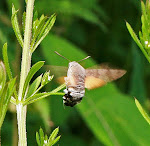.jpg)
July 14, 2008:
The Arctic or Polar fox (Vulpes lagopus) has a circumpolar distribution and lives in some of the coldest conditions in the world. In winter its thick, highly insulating fur is pure white but in summer, as shown here, it turns brown. It has furry pads on its paws which help to insulate its feet and give it traction when on the ice. Its sense of hearing is acute enabling it to detect prey even when under the snow. A mature animal can weigh up to 5 kilograms. Arctic Foxes occur in two colour phases, white and blue. The white phase is uniformly white in winter but becomes grey-brown on its back and thighs and cream on its belly and sides in summer. The blue form remains dark charcoal all year round. Where available, lemmings are the favourite diet but bird’s eggs when in season, fish, and carrion are also eaten.

The fox shown here on Spitsbergen was a white phase and was in the remote valley of Bjorndalen. Although in its darker summer fur, some white remains on its breast and ear tips. On these islands there are no lemmings and virtually no other small rodents, so in summer the foxes prey on seal pups, seabirds, Rock Ptarmigan and eggs. The bird cliffs here with their huge populations of nesting birds are a favourite haunt for foxes. In winter, apart from the Ptarmigan, they rely on food cached during the summer such as seal and reindeer carcasses as well as other carrion.
.jpg)
On Spitsbergen, the fox has no natural enemies or competitors. just a few resident trappers who are allowed to take animals under strict license during a limited winter season. This practice is traditional having taken place for hundreds of years. One estimate suggests that there is a density of approximately one fox for every 10x 10 km in Spitsbergen.
Below, Bjorndalen where this fox was photographed. Even at the height of summer, as here, it is a hostile environment for almost any form of wildlife.
.jpg)
.jpg)






No comments:
Post a Comment